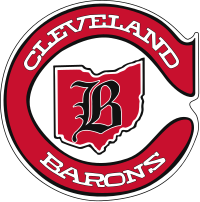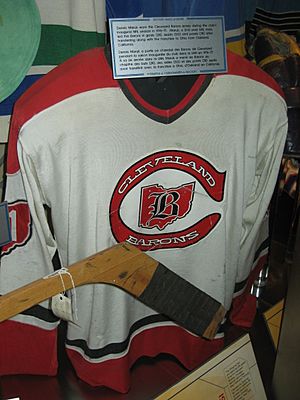Cleveland Barons (NHL) facts for kids
Quick facts for kids Cleveland Barons |
|
|---|---|
 |
|
| Founded | 1967 |
| History | California Seals 1967 Oakland Seals 1967–1970 Bay Area Seals (briefly) / California Golden Seals 1970–1976 Cleveland Barons 1976–1978 Minnesota North Stars merger June 14, 1978 |
| Home arena | Richfield Coliseum |
| City | Richfield, Ohio |
| Colors | Red, black, white |
The Cleveland Barons was a professional ice hockey team that played in the National Hockey League (NHL) for two seasons, from 1976 to 1978. They started as the California Golden Seals in Oakland before moving to Cleveland. After a short time, the team joined with the Minnesota North Stars (which are now the Dallas Stars). This merger meant the NHL had 17 teams during the 1978–79 season.
As of 2025, the Barons are the last team in the four biggest sports leagues in North America to stop playing. Ohio did not have another NHL team until the Columbus Blue Jackets joined the league 22 years later in 2000.
Contents
History of the Cleveland Barons

The Barons team began as the California Golden Seals in 1967. They were part of the 1967 NHL expansion, when the league added more teams. Plans for a new arena in San Francisco fell through. Because of this, the NHL allowed the team to move from Oakland.
A part-owner, George Gund III, convinced the main owner, Melvin Swig, to move the team to Cleveland. This happened for the 1976–77 season. The team was named "Barons" to honor a very successful hockey team. This older team, the Cleveland Barons, played in the American Hockey League (AHL) from 1929 to 1973. They won nine championships called Calder Cups.
Cleveland had been considered for an NHL team many times before. It was even mentioned in the 1930s. The city was turned down for an NHL team three times in the 1950s and 1960s.
The Barons played their games in the Richfield Coliseum. This arena was in Richfield, Ohio, a suburb of Cleveland. It was first built for another hockey team, the WHA's Crusaders, and the NBA's Cleveland Cavaliers. At that time, the Richfield Coliseum had the most seats in the NHL, with 18,544.
The NHL approved the move to Cleveland on July 14, 1976. However, the final details were not set until late August. This meant there was little time or money to tell people about the new team. The Barons never became very popular because of this. They rarely filled the Coliseum during their two years in Cleveland. Their first home game on October 7, 1976, had only 8,900 fans. They had 10,000 or more fans at only seven of their 40 home games. The team's attendance was even worse than it had been in Oakland.
In January 1977, the team's owner, Swig, hinted that the team might not be able to finish the season. This was because they had trouble paying their players and staff. He asked the league for help. The league did not believe the situation was as bad as Swig said. No NHL team had stopped playing in the middle of a season since 1917.
The situation got worse, and team workers were not paid for two months. In February, the team missed two more payrolls. The league thought about shutting down the team. By February 18, the players were very upset. They threatened not to play their game against the Colorado Rockies. To avoid a player strike and a team folding mid-season, the league and the players' association loaned the Barons $1.3 million. This allowed the team to finish the season. After the season, Swig sold his share of the team to George Gund and his brother Gordon.
For the 1977–78 season, the Gund brothers invested a lot of money into the team. This seemed to help at first. The Barons surprised the defending champions, the Montreal Canadiens, on November 23. A large crowd of 12,859 fans cheered them on. After a short struggle, the general manager, Harry Howell, made some trades. He wanted to make the team tougher. This worked for a while. The Barons beat three top NHL teams in a row in January 1978. These teams were the Toronto Maple Leafs, New York Islanders, and Buffalo Sabres. A few weeks later, a record crowd of 13,110 saw the Barons tie the Philadelphia Flyers 2–2. But this success did not last. A streak of 1 win, 13 losses, and 8 ties meant the Barons would not make the playoffs.
Merger and What Happened Next
After the season, the Gund brothers tried to buy the Coliseum arena but could not. The Barons were not very popular in Cleveland. So, the Gunds looked for a way to get out. Another owner tried to buy the Barons and move them to Houston, but this did not happen.
At the same time, the owners of the Minnesota North Stars were also having money problems. The league was worried that two teams might shut down. So, on June 14, 1978, the league allowed the two teams to combine. The new team kept the North Stars' name, colors, and history. The Gund brothers became the main owners of the North Stars.
The NHL later agreed to bring in teams from another league, the WHA, one year later. This meant that Ohio did not have a major league hockey team for 20 years. However, the NHL worked to keep hockey popular in the state. The Pittsburgh Penguins played two home games in the Richfield Coliseum in the early 1990s. The NHL finally returned to Ohio in 2000 with the new team, the Columbus Blue Jackets.
Dennis Maruk was the last player who played for the Barons (and the Golden Seals) to still be active in the NHL. He retired in 1989.
The North Stars continued to have money problems. The Gunds then wanted to bring NHL hockey back to the area where the Golden Seals used to play. In 1991, the Gunds were given a new team in San Jose. This team became the San Jose Sharks. In return, they sold their share of the North Stars. The league set up a special draft where the Sharks picked players from the North Stars.
Even though the Sharks are officially a new team, this move basically reversed the original merger. The Sharks now play in the same area where the Golden Seals played before moving to Cleveland. The new North Stars owners eventually moved their team to Dallas in 1993, becoming the Dallas Stars. The Gunds also later moved an AHL team to Cleveland. This team was called the Cleveland Barons from 2001 to 2006. They were a minor league team for the San Jose Sharks.
Season-by-Season Record
Here is how the Cleveland Barons performed in each of their seasons:
| Season | Team | GP | W | L | T | Pts | GF | GA | PIM | Finish | Playoffs | Avg. attendance |
| Moved from Oakland, California | ||||||||||||
| 1976–77 | 1976–77 | 80 | 25 | 42 | 13 | 63 | 240 | 292 | 1011 | 4th in Adams | Missed playoffs | 6,194 |
| 1977–78 | 1977–78 | 80 | 22 | 45 | 13 | 57 | 230 | 325 | 1010 | 4th in Adams | Missed playoffs | 5,676 |
| Merged with the Minnesota North Stars | ||||||||||||
| Totals | — | 160 | 47 | 87 | 26 | 120 | 470 | 617 | 2021 | |||
- GP = Games played
- W = Wins
- L = Losses
- T = Ties
- Pts = Points
- GF = Goals for (how many goals they scored)
- GA = Goals against (how many goals were scored against them)
- PIM = Penalties in minutes
Team Leaders
Team Captains
- Jim Neilson and Bob Stewart, 1976–1978 (shared the captain role)
First Round Draft Picks
- 1976: Bjorn Johansson (fifth overall pick)
- 1977: Mike Crombeen (fifth overall pick)
Head Coach
- Jack Evans, 1976–1978
General Managers
- Bill McCreary, 1976–1977
- Harry Howell, 1977–1978
See also
 In Spanish: Cleveland Barons para niños
In Spanish: Cleveland Barons para niños
- List of Cleveland Barons players
- List of Cleveland Barons draft picks
- List of NHL seasons

